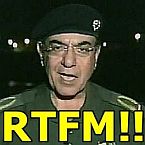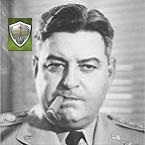vahauser
Posts: 1644
Joined: 10/1/2002
From: Texas
Status: offline

|
Here is a more lengthy and involved article from bayonetstrength(dot)150m(dot)com
A while ago, I got into a debate on the www.feldgrau.net forum. I had been scrolling through, looking for a subject I hoped I could offer some insight on, only to find most were too eclectic even for my tastes, when I saw one that seemed right up my street.
Someone asked what was the rifle strength of a 1941 German Infantry Division. There were a couple of offers of around 17,000, based on the personnel strengths and the number of rifles issued. Both options are technically valid. I offered a slightly lower figure: 3240. My total was based on the number of men in the actual Rifle Squads of the Division, not simply the establishment strength. It lead to a couple more posts between myself and another contributor who I think reckoned my total was 'absurd'. Still, I had good reason to defend my position, and the Rag Bag seems an excellent place to argue my case more fully.
What makes a combatant?
Every army, both today and during World War Two, divides its numbers between combat and service elements. The combat arms, infantry, armour, artillery, reconnaissance and engineer, are often referred to collectively as the 'teeth'. The service elements, transport, supply, medical, maintenance and training to name a few, are likewise referred to as the 'tail'. The number of men in the combat arms to those in the service elements is known as the 'tooth to tail' ratio.
It is a particularly important calculation as it dictates the scope of operations the entire army involved will be able to carry out. World War Two was arguably the first major conflict in which the tail achieved greater proportions than the teeth, as more men were drawn into the service elements needed to sustain the increasing levels of mechanisation.
This throws up the thorny issue of how many men could actually be described as combatants. It is difficult because it is entirely subjective. There are several ways to attempt to qualify a man as a combatant. He carried a rifle; he served in a unit which actively engaged the enemy; he served on the frontline; he actually saw the enemy. Any and all of these descriptions are valid. Yet the reality was that only a fraction of the men in an infantry division would normally be expected to engage the enemy directly.
But that cosy reality could disappear in an instant. If the enemy broke through into the rear areas the men in the supply and services units could not wait around for the infantry to turn up and repel them, they would have to do the job themselves. This was exemplified in actions such as the 'Admin Box' in Burma, where cut off rear echelon troops conducted their own defence. Likewise at Bastogne, all hands were needed to plug the gaps in the frontline. Still, these and other similar episodes were the exception to the norm. When a commander was forced to bolster his lines with rear echelon troops it was a sign of desperate times. Such men were not organised or armed for the task, and in some instances lacked the basic skills of field craft and marksmanship required. The German Army in particular made an attempt to address these problems mid-war, as the attrition of the Eastern Front thinned the ranks of their reliable infantrymen.
Battalion Bayonet strengths
Bayonet strength is an old fashioned description of the number of men found in the rifle squads and platoons. Foxhole strength is a more modern alternative, but I prefer the Napoleonic terminology. When attempting to offer comparisons between various armies it is important to be consistent, therefore the calculations below are based on the same formula.
Combat Infantry
The leading edge of any unit was provided by the men of its Rifle Platoons. Every man among its ranks was in a position where he was likely to engage the enemy at anywhere from a couple of hundred yards to point blank. Uniquely, the German Army deployed both medics and wagon drivers in its Platoon HQs. The former carried a pistol for self defence but cannot be counted as combatants. The latter apparently were held back with the Company transport under a 'vehicle leader', so are excluded from this exercise.
Combat Support
The increasing numbers of crew served weapons diverted further men from the rifle troops. While mortars were ideally held back, machine guns and anti-tank weapons needed to be pressed forward to engage. However, as their contribution was based on the weapons they served rather than their small arms, it seems reasonable to count them separately. All support platoons inevitably contained personnel who may be more properly counted in the following category, but for simplicities sake they are treated as complete entities here.
Command & Administration
Every level of unit from Platoon up had some form of Headquarters, encompassing officers, signallers and messengers. While still drawn into the frontline, their role was more in directing the efforts of the combatants rather than adding to the fire.
Likewise, with anywhere from 500 to 1000 men found in various types of Battalion, specialists were needed to sustain the fighting groups. Clerks, mechanics, medics, repairmen and drivers were found along the length of a Battalion's lines of communication.
Comparisons
The numerical figure shows the numbers of officers and men who fall into the categories described above, the percentage figure being given in brackets. Percentages are rounded to the nearest whole. For a detailed description of the battalions examined here, please refer to the Index page and the Example TOE pages.
Infantry Btn Combat Infantry Combat Support Command & Admin
British (1944) 444 - (52%) 183 - (22%) 218 - (26%)
American (1944) 369 - (42%) 297 - (34%) 205 - (24%)
Russian (1943) 360 - (59%) 184 - (30%) 68 - (11%)
German (1941) 432 - (50%) 150 - (17%) 278 - (33%)
German (1944) 270 - (38%) 222 - (32%) 216 - (30%)
Points of note
There are some interesting points that emerge.
The British Battalion placed half of its manpower directly into its twelve Rifle Platoons. Anyone who has read even a few accounts of British actions will know the riflemen carried the burden of the advance. The combat support elements served quite a number of weapons, six mortars, six anti-tank guns and a dozen carriers excluding numerous HQ vehicles. A full quarter strength deployed in command and admin seems excessive perhaps, but Battalions were self contained and had no Regimental service assets to call upon as did other nations.
The United States Battalion had the lowest allied percentage in its nine Rifle Platoons, quite surprising really. The larger percentage in combat support is partly due to the inclusion of a Weapons Platoon in each Rifle Company. I was in two minds as to whether they should be counted as combat infantry given their proximity to the action. If so, the level is increased to 50%, perhaps a fairer indication? They served nine light and six medium mortars, six light and eight heavy machine guns and three antitank guns. The command and admin figures are swelled by the 'Basics', unallocated riflemen included in each Company HQ, seemingly to replace losses in the platoons. Their numbers were reduced mid 1944, as noted elsewhere on the site.
The Russian Rifle Battalion is striking. Only around one in ten men not serving in a direct combat capacity and well over half the strength in the nine Rifle Platoons. The combat support served six light and nine medium mortars, twelve heavy machine guns and two antitank guns. These figures are based on the final modifications of the December 1942 tables. During mid 1943 the reduced strength savings detailed in The Red Army pages began to bite. Oddly, these reductions actually increased bayonet strength while reducing weapon crews. However, the subsequent reductions began to whittle away at the rifle squads while maintaining the lowered number of support weapons (six medium mortars, nine heavy machine guns and two AT Guns).
The German Battalions are the most revealing. I thought it worthwhile showing both their versions to demonstrate how savage the mid-war reductions were. The 1941 model placed great emphasis on the men of the nine Rifle Platoons, with half the strength of the entire Battalion. Support weapons of twelve machine guns and six mortars had the lowest allocation of personnel in this amateur study. The command and admin group is by far the largest, and the Germans still held considerable service elements at Regimental level. The 1944 model shows dramatic changes. Rifle strength had fallen by over a third, an immense drop. Weapons crew had increased by half in comparison, but only served an additional four heavy mortars. The command and admin groups remained practically unaltered. The 150 man reduction between the 1941 and the 1944 models was borne entirely by the Rifle Platoons, the men released by pruning the Train elements all going to the crew served weapons.
Divisional implications
Infantry Divisions are notoriously elastic formations. I wanted to offer some more specific figures than those below, but given the variations, in German units in particular, opted for approximations instead.
Infantry Div Combat Infantry Div total (approx) Bayonet %
British (1944) 3996 18,500 22%
American (1944) 3321 14,500 23%
Russian (1943) 3240 9,500 34%
German (1941) 3888 17,000 23%
German (1944) 1890 12,500 15%
Accurate comparisons between divisions are particularly difficult.
US Divisions operated with supporting arms such as Tank Destroyer and Anti Aircraft Battalions routinely attached, but they were not included in the establishment strength. A US Division was nearer the size of a British one when these men were counted.
The German 1944 model is the only one not based on nine Infantry Battalions. Each Regiment had lost its third Battalion, but the Fusilier Battalion is included as this helped alleviate the reductions.
Points of note
Generally speaking, only one man in four was likely to be placed in a unit whose primary mission was to engage the enemy on foot and with small arms. Three quarters of the Division were tasked with the operation of crew served weapons or command, control and administration duties. The reformed Soviet Divisions increased their bayonet strength to one in three, the highest of any combatant in the European theatre.
The real shocker is the 1944 German Grenadier Division. The much vaunted reforms of 1943 were supposedly aimed at reducing the tail to reinforce the weakened teeth arms. Instead, they reduced bayonet strength from one in four to just one in six. The numbers of crew served weapons were mostly maintained, and in some areas increased. The Germans plainly believed that superior firepower was the best defence against the allied onslaught. The intriguing thing is that the percentage is not too dissimilar from modern day units (a 1990's era US Army Heavy Division posted 16% foxhole strength).
Exceptions to the rule
Mention should be made of the infantry who served in two other important Divisions; the Armoured and the Airborne.
Armoured Infantry commonly deployed fewer men in the foot assault role than walking units. A US Armored Infantry Battalion for example was 1001 all ranks in early 1944. Of that total 504 men were in the nine Rifle Platoons. But with just three Armored Infantry Battalions there were only some 1500 men from a strength of over 10,000 men.
In the Airborne Divisions things were very different. While organised into fighting and admin groups, the propensity for parachute troops to be scattered upon landing meant every man in the Battalion had to be considered a frontline soldier. When drawn into the more traditional role of infantry later in the war for the allies, much earlier for the German, the distribution of troops took on a more usual appearance. However, Airborne troops still retained the ability to mobilise their tail units into effective teeth formations.
Summary
The figures above are by no means an attempt to exclude certain types of troops from their role in combat. The Reconnaissance Regiment of every British Infantry Division was always to be found leading the way, probing routes of advance and often undertaking 'reconnaissance by fire' - a terminological disguise for saying 'if anyone shoots at us we'll know there is someone there!'. The Reconnaissance units of all armies often operated on foot, fulfilling the same role as Infantry.
Likewise, the Engineers were to be found at the front, repairing bridges or blowing them up as necessary. Anti-tank guns and machine gun crews, while able to engage at distance, could be found dug in among the rifle pits and trenches. Their contribution cannot be ignored.
But if there is one thing this exercise has confirmed for my mind, it is this. I have been reading accounts of wars and battles since I was at school. Repeatedly, you come across the phrase 'the attack was repulsed with heavy losses inflicted' or such like. Very rarely does an author attribute an actual number to those losses. When they do, a total of say 150 men killed and wounded for a single Battalion during a contested offensive, it's easy to think those losses were incurred from a body of some 800 men. But when looking at the number of infantrymen usually committed, you are talking of those casualties being taken by perhaps 400 men, less if a company was held in reserve. In this imagined example that is a casualty rate of around one in three. It is quite a sobering thought.
It was the responsibility of the men of the Rifle Platoons of an Infantry Division to maintain the integrity of the frontline and keep contact with the enemy. They required both mundane material support as well as cannon, guns and mortars. Practically all the other elements of the Division were geared to keeping the riflemen in combat. When Divisions were pulled back to rest and refit, make good their losses, it was primarily the infantrymen they needed to replace. A constant flow of men went into their ranks and came out normally only as casualties. If the infantry component of a unit was savaged, it compromised the ability of the whole to remain in the field. When you read about Divisions being pulled out to recuperate, it was rarely because of exceptional events such as artillery batteries being overrun, or Headquarters troops being captured. It was more due to the fact that their bayonet strength had been so depleted by constant exertions the basic squads and sections could no longer function.
There is tremendous scope for argument as to what truly constituted bayonet strength, this is just my version and does not disagree too much with those of more accredited commentators. But it is no coincidence that offensives began to stutter and stall as the casualties in the frontline troops began to mount. Commanders could pour as much fire down as they wanted on the enemy positions, but as in every war before and since exploitation by foot soldiers was the deciding factor. It was all too easy for a reckless General to burn out his precious reserves of flesh and blood in a foolhardy attack, and then wonder why he could not hold onto the gains they had made.
The riflemen were the lifeblood of every infantry division. Once drained, it was particularly hard to replenish. The Second World War was a true 'all arms' conflict, but the burden of attack and defence was carried by a relatively small proportion of the troops involved.
_____________________________
|
 Printable Version
Printable Version

















 New Messages
New Messages No New Messages
No New Messages Hot Topic w/ New Messages
Hot Topic w/ New Messages Hot Topic w/o New Messages
Hot Topic w/o New Messages Locked w/ New Messages
Locked w/ New Messages Locked w/o New Messages
Locked w/o New Messages Post New Thread
Post New Thread